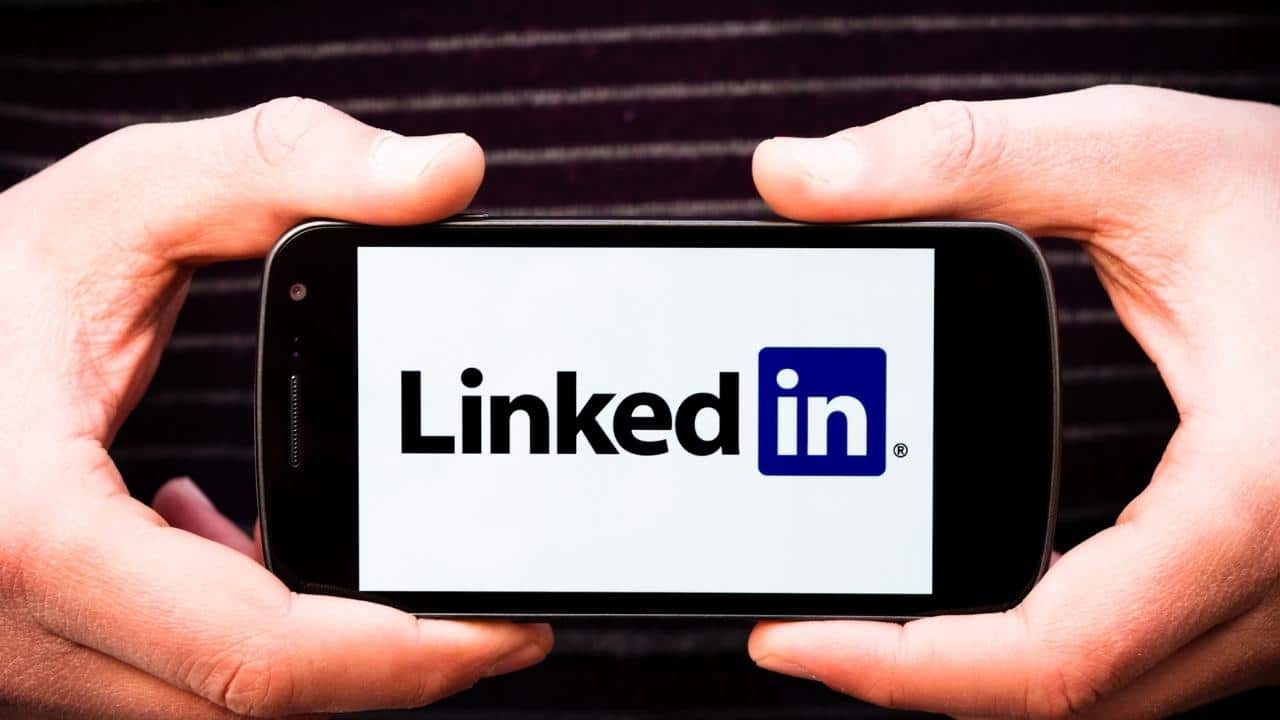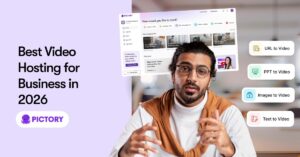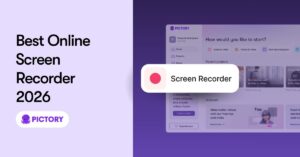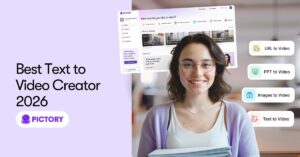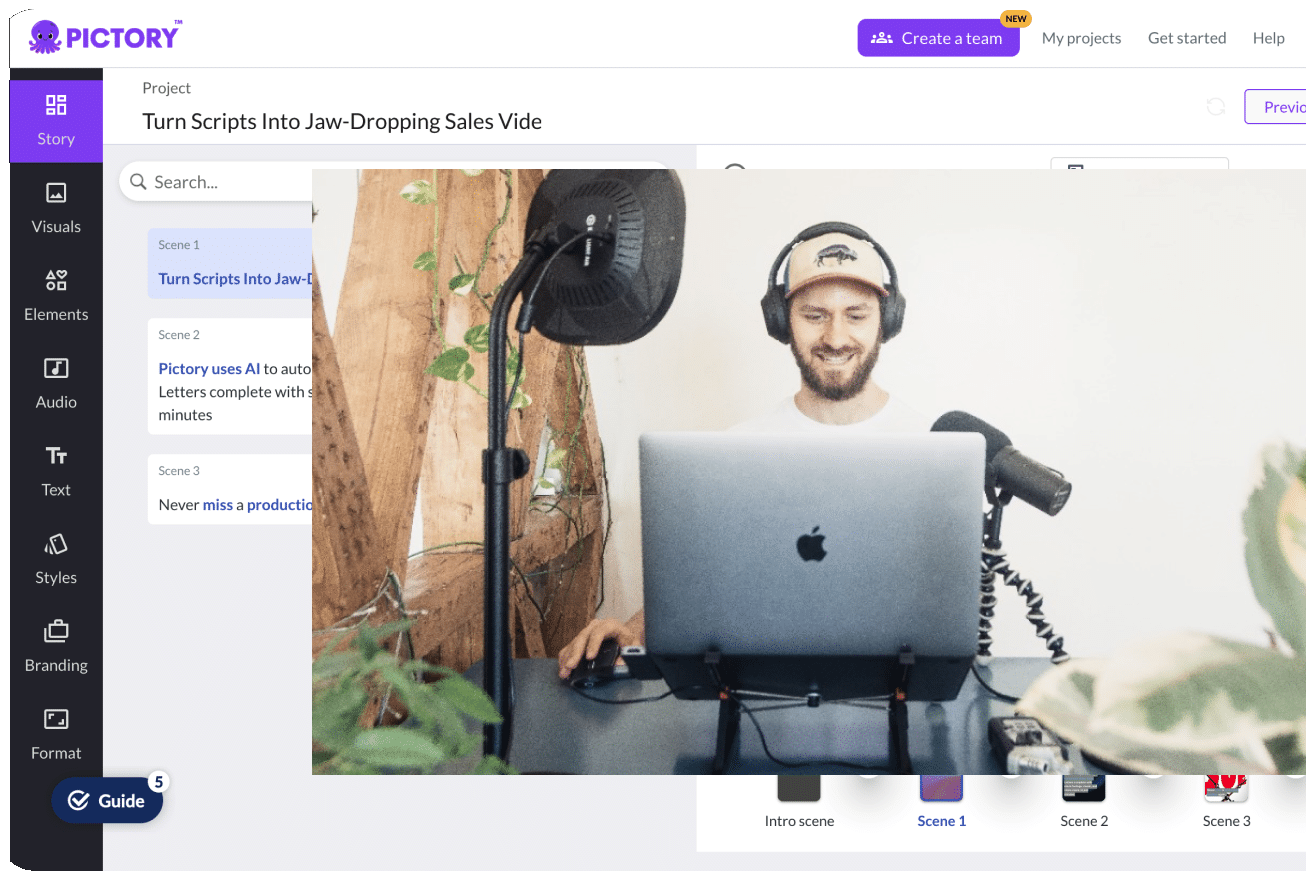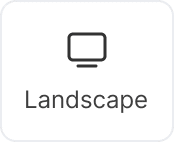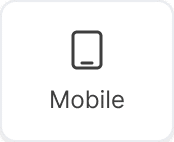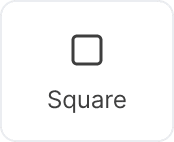Vikram Chalana
So welcome everybody to this episode of the Pictory podcast.
And I wanted to introduce myself and pick up a little bit the topic today is AI in sales and marketing, on LinkedIn, specifically for LinkedIn.
And we all know LinkedIn is where all the sales and marketing action is these days. And and we all know that AI is eating the world in so many different ways.
And, and so we felt like it was a really good combination of for, especially for people in b2b, to talk about LinkedIn as well as AI and how it’s impacting the world.
And my background really quickly I am, I’m the founder and CEO of Pictory. And Pictory.ai is we’re a company based here in the Seattle area.
And we we’ve been building a platform that leverages AI for, for creating videos and editing videos and making videos really easy, especially.
Specifically what we do is we turn long form content, whether it’s a long webinar, or a long text blog or white paper into short videos, because on social especially on on LinkedIn, short videos will grab attention, then you can use that as teasers to bring people into watching your longer form content or, or reading your longer form content.
And we have several pieces of AI in our platform, that that helps create the videos. And I’m super excited today to have Thorsten Linz here and personas is with a company called innovative AI. And they have been using AI for sales activities and marketing activities.
And Thorsten himself, let him talk about his background.
But he he’s at the forefront of AI in so many different ways. So welcome to Thorsten. And I would love to start with a little bit of your background.
Thorsten Linz
Okay, thank you. Yes, my name is Thorsten. And I’m actually based in Berlin right now. Last year, I mean, after going on a trip to Europe, I actually couldn’t go back because of the travel ban.
So actually, I built I mean, a continue to building our business from here.
So in general, my background is in digital marketing and CRM. I’ve worked for global advertising companies, and spent a lot of time in China, in the US, and of course, in Europe. And when I quit my job in 2014, when I was working in Chicago, I went to Silicon Valley, I started a innovation business, and became part of Singularity University, and started actually coaching startups.
And the biggest challenge that we ran into was, I mean, how do you validate a business idea on scale?
And I mean, that was one of the biggest problems, because usually, I mean, you run like an experiment, you run it, like, I mean, I mean, just on LinkedIn, right, in one market.
But the challenge here was, how do you scale I mean, your business idea testing electronic markets, and there wasn’t actually anything available yet at that time.
And the other issue was, I mean, the clients that we were working for, they never had, like the patience and the resources in order to spend like six months validating a new product idea.
Well, this is actually when we actually started creating, I mean, around the platform idea. And the platform actually became a dashboard.
And we started as a SaaS business. And we started actually in Seattle. And now we are like eight iterations later, we became an automation company, and we offer done for you services, because we figured a SaaS business.
A pure SAS play for what we do is very tough. It’s very hard. But with AI actually coming into the game now, we will eventually become a SASS platform again in the future.
From a company point of view, we work for a lot of accelerators in the US, such as startup Haven and Seattle, we work for textiles and Google for startups. We have clients in Berlin and Paris and Brussels all over the US bootstrap companies SMEs and corporate innovation teams.
Vikram Chalana
Awesome. Awesome. And seems like your your customers are largely b2b companies, b2b SaaS companies, startups or existing businesses, long term businesses. Talk about how you yourself use LinkedIn and any tips for our audience here.
Thorsten Linz
That’s a good one. Yeah. I mean, LinkedIn just imposed the 100 connection requests limit for a week, everybody has been affected by that.
And before that, I used to send out about 500 connection requests a week, to people I want to meet. And since I mean, that limit has been put in place. I mean, LinkedIn doesn’t scale anymore.
So there are different ways now how to do this. But But the internet in nutshell, I mean, LinkedIn is good if you want to build relationship, if you really want to start a conversation about a product, or I mean about an idea. But what happened is actually that many people use LinkedIn as a sales platform as it gets spammed everybody knows these messages, right.
And this is why LinkedIn had to respond to this. So they really cut this down. The way I use LinkedIn, personally, is building my relationships.
I mean, providing content on LinkedIn, and really building my own brand, which is actually I mean, I mean, especially for b2b companies, that ours, LinkedIn has the perfect infrastructure for that.
Looking at the opportunities, I mean, which you still have on LinkedIn, LinkedIn still offers so many, many opportunities to steal content, like 800 InMails, or they call this open InMails per months.
So everybody who has like an open InMail profile, can be contacted without actually sending a connection request.
And this is how you actually go around this limit. I mean, targeting talking about LinkedIn groups, I mean, I mean, there are so many AI based LinkedIn groups, and you actually can send free messages to everyone in this groups without actually using any of your LinkedIn connection requests.
And then you can start hijacking, this is what we do, right?
So find your competitors, look up their events and actually scrape actually all the participants and try actually, to get in contact with them.
This is how you actually get a new customers. And finally, I mean, you still can upload your address book to LinkedIn.
And this is interesting, because if you upload your address book, I mean, the 100 connection, because limit, I mean, doesn’t affect you at all, you can have, like 5000 people on your address book on your on your on your mobile device.
Once uploaded, LinkedIn connects to these folks automatically.
And this is I mean, a few tactics, how you actually I mean, go around the 100 connection requests limit per day, or per per view per week.
Vikram Chalana
Awesome. Awesome. How a How does your platform use LinkedIn? In your I know you? You’ve built this nice selling platform b2b sales platform. How do you use LinkedIn for that?
Thorsten Linz
Good question. I mean, number one, it’s actually data in LinkedIn, we have more than 700 million profiles use us.
And we scrape that data. And on LinkedIn, especially if you’re using Sales Navigator, you have 28 data points that you actually can use for your own targeting.
If you have, I mean, just a standard or regular profile, you have like four data points. If you have LinkedIn premium, you get like 14 data points.
But if you’re into sales, you need to use Sales Navigator and because of the available data.
And we use it, of course to run our own targeted campaigns on LinkedIn for us and our customers. But as far as messaging is concerned, we’re doing two things.
Number one is we do a lot of personalization of LinkedIn messages. I mean, as it goes, right now you have like a message to send out your personalised first name and last name, and maybe a company name.
What we do is we personalise images inside of LinkedIn messages.
So and we tap into these 28 data points and pretty much any image we can personalise that was like a name. I mean, was, I mean, even with your profile image, I mean, it was your company location, everything.
I mean, what gets our message across, I mean to our target audience and gets them to respond. I mean, this this is one part.
In addition to that, right now, we are playing with conversational AI. And conversational AI is actually a platform that ties into our platform.
Now, the auto generate messages for our customers. You don’t tell our customers yet because we are playing with this and the point here is auto generated AI generated tech So sequences, you can actually spot the difference immediately.
So my team actually sits behind it, they run the AI, generate the messaging sequences, and then we like error, check all of this, and then we test it. And we do this on LinkedIn. And we also do this on cold email marketing.
And again, looking, I mean, at LinkedIn, in general, and our platform, we are trying to build a predictive model here, that we will be able to see if a business idea succeeds or fails in the future.
So that means I mean, tapping into LinkedIn data, getting into the data points, and actually, measuring how people respond to AI generated messages will help us actually to accelerate our own process.
Vikram Chalana
Okay. Okay. That’s pretty awesome. So So you’re using AI in two different ways in your platform.
One is what you mentioned is configuring images that are that use the power of your prospect to information on your name, and company name, and so on.
And then you also are using it for generative text and generated messages. And you’re testing that out to see if, if, if people respond or positively or negatively to these AI generated messages.
Thorsten Linz
Yes, we in b2b, I guess we are kind of used to AI right now. And even if you spot a message that has been written by an AI, we will probably respond to that message.
If you’re a b2c marketer, this is totally different. Because in b2c, I feel like AI is going to be very tough, because it needs to be very emotional, right? In a b2b contracts, it’s about I mean, I mean, transmitting or transporting the facts, I just need to see the facts of a message, which is it’s different.
So playing with that in b2b is quite interesting, right? And especially for us, because we want to measure the results and see how many I mean, how can we actually take up the conversion rates by using AI?
Vikram Chalana
Yeah, awesome. Awesome. So let’s talk a little bit. Let’s switch to AI now. And we’re kind of already talking about the AI powered content in specifically text content.
And you talked about image content. Let’s talk about videos. And how do you use videos today in in your platform? And how how do you see videos being used in general in LinkedIn?
Thorsten Linz
I mean, videos in general, I mean, we’ve seen that on all the other platforms, right? Videos, drive engagement. And if you look at LinkedIn today, it feels sometimes like Facebook and 2012. But you see, actually a lot of videos popping up right or left that I mean, especially like in b2b sales. I mean, videos are very important because videos drive engagement.
We are used to I mean, to get all these mean, texts, I mean, messages getting like emails, but videos actually interrupt mean like your day and actually videos can help you explain a very difficult product in a different way.
But because it’s like listening, it’s the visuals instead of just reading I mean, your your, your email, or I mean a booklet.
So what we found out is that that was video, the engagement rate goes up and the conversion rate goes up. And the way we use it right now, we are using another AI here it’s caused in Vizio, and I mean they are hyper personalising videos.
So what we do actually was images, and what we do with with on LinkedIn messages and our language and conversion AI, we also can do this with video. So what we do is we take the tack from LinkedIn, and use Zapier recipe and insert this tag into the video and it’s auto generated, right?
The minute the SAP runs, it takes a minute or two to generate a video, enter send an email to somebody which is hyper personalised, so if somebody books a meeting actually with me or my Calendly account, what happens once the email address is on our system on our Active Campaign to Zapier runs, right and sends our confirmation video instead of an email.
Vikram Chalana
Wow. And it’s hyper personalised. It comes like as the first name, the company name and the meeting date.
Alright, so this video the video has I’ve seen some of the synesthesia videos so they have avatar So you have created a personal avatar for yourself. And that reminds the prospect that, hey, you have a meeting scheduled.
Thorsten Linz
And here’s the time and date and uses their name. And they give you 40 different avatars by now, right? So you can pick actually, I mean, in feet female male age, right, there are so many different different actors to choose from.
And the interesting thing is here, you can upload your own avatar. So they actually need a four minute video of yourself reading from a script. And then they actually do some magic in a week later, you get your own avatar, which actually speaks 44 languages.
Vikram Chalana
Wow, that’s pretty cool. That is that is where the future of of some of this generated video is, is going you can see that and and do you. So this is one part this personalization of videos, do you see? Do you see more traction with these personalised videos? Do you see open rates higher? Do you see response rates, higher things like that.
Thorsten Linz
I mean, it’s number one, it’s a talking piece at the beginning of each and every meeting, which is a good opener. But I mean, for our clients who use actually, these who use these avatars, what we provide is actually a sales follow up process.
So we tag a client in our system, or a customer or system as being say, a French person. So we actually get a French video out, and it’s going to be a French sales presentation that goes out to that person immediately.
Right, you can scale actually, all of this, whatever you use so much time actually recording videos, and see you need like 20 takes sometimes I had to do a video, because that system right now it’s just entering text, pretty much and and that’s it right? And it generates the video, they still have a few issues when it comes to the language, right?
I mean, there are some nuances they have to figure out. But I mean, all in all, it’s I mean, very good product. And some of our customers start using actually that product right now just in order to get that sales pitch out in the market. And it’s being used for follow up sales calls. So it’s actually all the follow up stuff after the first call in order to get folks to the next sales meeting.
Vikram Chalana
Right? Yeah. Yeah, it’s, it’s great. Right now, it’s, I like the robotic, the generative power of it. But there is a robotic aspect of it, which, which I know from marketing perspective, I don’t know that it’ll, it’ll fly very well. In the, in the beginning,
Thorsten Linz
it’s a very good point, to be honest, right. And for we did on our own of our trials, we actually mean call them the virtual AI assistants right from the beginning. So you’re not trying to fake any human here.
I mean, they are virtual AI assistants. And this actually puts this on a whole different level immediately. Because people are used actually to I mean, AI is right, and if you try to fake folks, and this is going to be a different story.
Vikram Chalana
That’s fantastic. That’s fantastic. So switching a little bit to Pictory. And because we’re talking about videos here and and picture is all about videos as well, is slightly different, the use cases are slightly different.
And you’ve been a victory user yourself for a few months now. So tell us a little bit about how you’ve used it, how you found it useful.
And then I’ll talk about kind of the vision that we have in the future of how we can get more AI in there and how we can create even more of these personalised videos as well.
Thorsten Linz
I guess the biggest advantage is time saving. This is I mean, the biggest mean use Pictory for us because when we do our own webinars, it used to take a day or two days just to edit down the video and to get it right and we had like two people actually just getting down on the video production here and to chop chop it down for social media.
My first video was you guys took me 90 minutes, but it was like a it was pretty much like a two hour video.
And what I liked actually that you can actually cut it down into pieces and it summarises pretty much the video that was actually a cool feature.
But what I really enjoyed was actually the the language that the speech to text translation right?
And just pretty much editing all the text and cutting the video actually by editing the text. I mean that was like really cool.
So it helped me a lot. All in all, I mean, a great product. And again, we have Jen here who’s going to use the product in the future. Because for us as a company, we will be generating way more videos, right? But we were lacking in the past is actually the tools in order to really scale that process.
Vikram Chalana
Yeah, yeah. And in terms of the human, I think that’s, that’s the, that’s the thing we realised is people really connect with videos where folks are talking, this kind of videos that we’re producing right now with you and icon conversing.
And, and people connect with that, and, but one of the challenges that we’ve realised, everybody we’ve talked to, they spend more time, like, multiples of more time, editing videos, then actually producing the videos. Yeah, that’s true.
Like, whether it’s elearning, whether it’s marketing, whether it’s external training, internal training, any of those scenarios, and people are spending, people spend a lot more time editing videos. So our goal was to see how we can make the editing of the video really easy.
And most of the videos that we’re talking about from the business b2b context are videos with speech.
So we can convert the speech to text and then just make editing, as easy as as editing text, which is, which is what picture is, or has been all about, in terms of AI functionalities, what what we are, we have, the first piece of AI is that transcription piece, so we take the speech and convert it to text.
But there’s there’s many other pieces of AI that are in Pictory, for example, you talked about the summarization piece.
So right now, you can basically press a button and you say is summarise the transcript into some key key messages.
So we use natural language processing for that and come up with the, with the key messages around that.
And at the end, the goal is to create short videos, that that you can post on LinkedIn that grabs people at people’s attention and bring them into watch your whole webinar.
And the the other piece that I’m not sure you’ve tried yet, Thorsten, is that we also have a piece where we can actually generate videos starting from text, they’re very different from the synaesthesia. Visio videos.
They are they use stock content, and and then they also do the rendering of the text in with speech. But there is there isn’t a human or avatar speaking, but but there is stock imagery.
Thorsten Linz
I’ve seen that I’ve seen that but haven’t used it.
Vikram Chalana
Yeah, yeah. So that one is another so there’s another there’s more pieces of AI in there as well that like the, the rendering of text to speech is one piece, the summarization of a blog post into into shorter pieces, that’s, that’s another second piece of AI, then there is an AI that we use to, to find the best matching stock image to a given sentence.
So if you have 10 sentences that you want to create a video from each sentence may have a different stock image or a video that we
Thorsten Linz
Akira by picking Akira, how does it work?
Vikram Chalana
Yes, yeah. So so it’s a, it’s a bunch of different algorithms that we use in there. But it starts with the keyword. And and we identify the keywords in the article, then we identify the keywords in the sentence.
And then we also identify the category of the article. So if it’s a technology article, or it’s an article talking about, you know, lifestyle, or, or sports or whatever, and then we kind of narrow the search of the images, using the categories using keywords. And then we also use computer vision in there.
So for example, with computer vision, we can tell what objects are contained in the image or the video. And that gives us additional tags that we can we can search on. So wherever you take this platform in the future, yes.
Yeah, the the main, the main goal for our platform is really helping in marketing and sales. And then personalization is is of course one of our long term strategies here as well. So you can imagine now instead of Avatar, imagine me recording my own voice in a message and and and you can now change that. Whereas in my original recording I might have said, Hi, Kirsten, and how are you and this is messages for ena where I could change the name and the company name in my own voice and my own face, as opposed to using an update.
So there’s there’s still a while to go here there is people working on that it’s still cutting edge of research here. And but but we’re pretty excited about that.
Thorsten Linz
That was all of this. I mean, it’s just around the corner.
Vikram Chalana
Kind of it is yes, it is.
And and I think the other key piece here, where with where your platform and our platform can pay really well is affectivity of the messaging, right? I mean, we’re measuring affectivity of videos on LinkedIn, the number of likes engagement metrics you get, or through email, the open rates or the response rates you get, those are all metrics that need to tie back into improving the AI and making the AI better and in the learning process.
Thorsten Linz
Makes total sense.
Vikram Chalana
So any any final thoughts on LinkedIn AI, where where do you? Where do you see your platform going in the future, and just let’s chat of
Thorsten Linz
Sales automation will be automation. I mean, it will be a combination of automation tools and AI, right, and some predictive analytics.
And we will have actual events need SDRs anywhere in the future. But we will just have the algorithm run and run and run. And, and we see this actually from results right now. I mean, the system works, it generates results, right?
The question is, can we put it on auto run without actually human intervention? Is this the question? If this is possible?
Yeah, this is going to be a goldmine for any business, right? Just look at the labour cost on one side, right?
That’s, of course, the downside when we talk about labour, but with automation tools, it’s all the tedious stuff that you can I mean, automate and actually can help. So I mean, low wage folks really to go into like sales positions.
And so I’m looking forward to that future. Personally, I see a lot of opportunities and as is, of course, a few, I mean, risks involved. But I mean, this is always when it comes to technology and new technologies. There’s always a risk. Yes, and it’s overused actually that technology then.
Vikram Chalana
Yes, absolutely. And are our future. I see it as more democratization so you’re you’re talking about democratization of sales. We’re talking about democratization of video, and I think they will they will intersect very nicely in the future.

